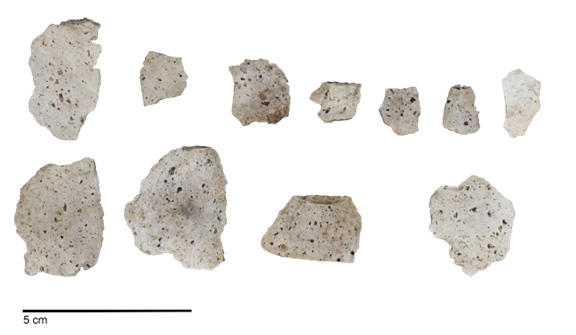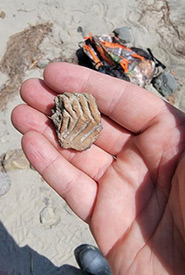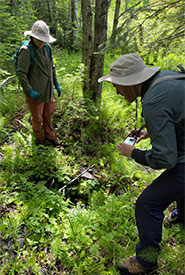Archeology is helping to restore natural and cultural connections on the lands of the Ndakina

Stone chips from the manufacture of tools unearthed at Portage Lake. (Photo courtesy of Ndakina Office of the Grand Council of the Wabanaki Nation)
By: Geneviève Treyvaut and Alexandre Tellier, archeologists in the Ndakina Office of the Grand Council of the Wabanaki Nation, with Hubert Pelletier (NCC)
Over the last few years, the Ndakina Office of the Grand Council of the Wabanaki Nation (GCNWA) and the Nature Conservancy of Canada (NCC) have been using archeology to assist with conserving the cultural heritage of Indigenous communities. The Office of the Ndakina led archeological projects on two NCC properties in 2022.

One of the 27 pottery shards unearthed at Bouchard Island. (Photo courtesy of Ndakina Office of the Grand Council of the Wabanaki Nation)
The first project took place on conservation lands in Lac du Portage, in Beauce County, at the border between Quebec and Maine. The lake is located in a trading area used by the W8banaki and Wolastoqiyik Wahsipekuk First Nations. The second project occurred on Île Bouchard, an island in the St. Lawrence River, east of Montreal. The Ndakina office of GCNWA, the Mohawk Council of Kahnawá:ke and the Office of the Nionwentsïo of the Huron-Wendat Nation all collaborated on the archeological surveys. NCC staff have also assisted by sharing resources and expertise, and have accompanied archeologists to both areas. These collaborations have inspired a rich dialogue about the role of conservation sites, their meaning for Indigenous communities and Indigenous traditional use of natural resources.
Both archeological surveys have revealed new artifacts, adding evidence about the presence of Indigenous Nations in this landscape prior to European settlement. These findings are not surprising, as they confirm what Indigenous oral tradition already claims: that Indigenous Nations have lived on these lands since time immemorial. It is the first time Indigenous artifacts were uncovered on an NCC site in Quebec.

Archaeologists from the Grand Council of the Wabanaki Nation document the surroundings of Portage Lake. (Photo courtesy of the Ndakina Office of the Grand Council of the Wabanaki Nation)
NCC’s conservation mandate fits well with the archeology of Indigenous Nations. The practice of archeology considers that cultural heritage, including archeological heritage, cannot be separate from natural heritage. The protection of archeological sites can be supported by natural area conservation measures and their buffer zones. The Lac du Portage and Île Bouchard sites hold a particular importance for the W8banaki Nation; these areas are part of traditional river networks used for travel and trade, as well as to access resources and participate in cultural practices.
Today, both natural and cultural heritage are under pressure from modern lifestyles and disruptions throughout the landscape.
We are grateful for these collaborations. The Ndakina Office of the GCNWA and NCC look forward to continuing to work together to ensure such a legacy endures.
Thank you to the donors who made this project possible





